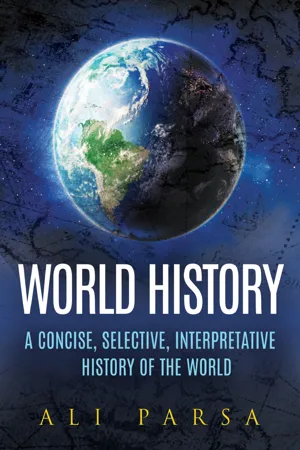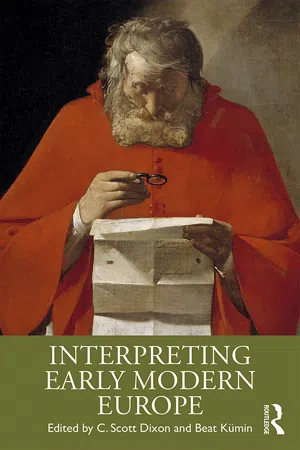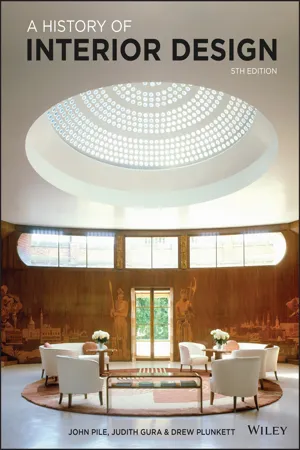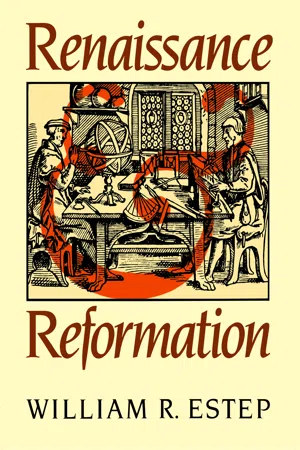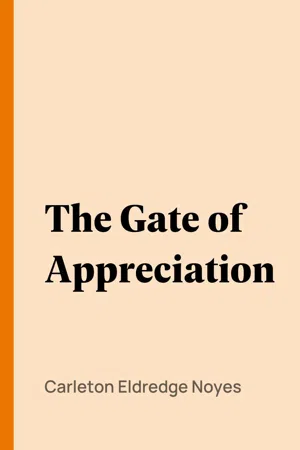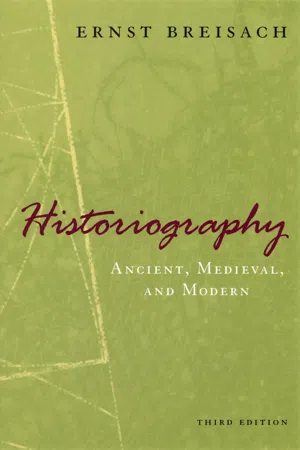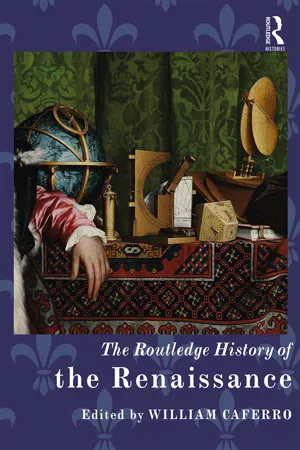History
Italian Renaissance
The Italian Renaissance was a period of cultural, artistic, and intellectual flourishing in Italy from the 14th to the 17th century. It marked a revival of interest in classical learning and the arts, leading to significant advancements in literature, architecture, sculpture, and painting. The era also saw the emergence of influential figures such as Leonardo da Vinci, Michelangelo, and Raphael.
Written by Perlego with AI-assistance
Related key terms
11 Key excerpts on "Italian Renaissance"
- eBook - ePub
World History
A Concise, Selective, Interpretive History of the World
- Ali Parsa(Author)
- 2017(Publication Date)
- Sentia Publishing(Publisher)
Now, let us get started with the discussion of the European Renaissance. At the outset, I must clarify one of the most common misunderstandings of what Renaissance means. Most people associate the term Renaissance mainly with fantastic art, paintings, and architecture produced by great masters, such as Michelangelo, Rafael, and da Vinci. But in reality, the Renaissance was a much broader intellectual-humanistic transformation that changed the whole worldview of Western Europeans and subsequently the whole world. Art and architecture, as beautiful and publicly enjoyed and appreciated as they are, are only the products of a much bigger change.Renaissance means rebirth. Something must die in order to be born again. That one thing, according to the people who invented the term in the fifteenth century, was the glorious classic era of the Greco-Roman times, before the fall of Rome in the fifth century, when human beings were valued and creativity was rewarded. Out of the ashes of the Late Middle Ages, which were dominated by dogmatism and otherworldliness, a new focus on human beings began.The Renaissance HumanismA good way of understanding the essence of the Renaissance is to break it down into its three major aspects. The first aspect of the Renaissance, as it is most easily understood, is the yearning for the classics. It is not surprising that the Italians, who considered themselves to be descendants of and successors to the great Roman civilization, would be the pioneers of this movement. The father of Renaissance humanism is Francesco Petrarch. Although Italians had become wealthy through international maritime trade, they were politically divided. Feudalism, as had been developed in the rest of Europe, was not as strong in Italy. Instead, an urban economy with a growing middle class was taking shape. Petrarch, who was an erudite man, well versed in classical Latin and possessing a great knowledge of history, should be credited as the first person who tried to awaken the Italians to their glorious past in which human beings were valued and individuals were respected. - eBook - ePub
- C. Scott Dixon, Beat Kümin, C. Scott Dixon, Beat Kümin(Authors)
- 2019(Publication Date)
- Routledge(Publisher)
4 Renaissance Edward Muir The interpretive challenge for Renaissance studies began in the nineteenth century, not the fourteenth, fifteenth, and sixteenth, the age of the Renaissance. Unlike the Enlightenment, no one living during the Renaissance knew about it. An ardent anti-clerical republican, Jules Michelet (1798–1874), popularised the term Renaissance (rebirth), and hence the French word still prevails in the English-speaking world in place of the Italian Rinascimento. A whiff of Michelet’s secular prejudices still lingers over the idea of the Renaissance. During the same period the Swiss Protestant, Jacob Burckhardt (1818–1897) wrote The Civilization of the Renaissance in Italy, which introduced art and cultural history as a pre-eminent means for understanding the period. Burckhardt’s innovative approach of Kulturgeschichte has been especially attractive because of his evocative portrait of how political illegitimacy produced artistic and intellectual vitality, epitomised by his famous phrase, ‘the state as a work of art’ (1958, 21). The Prussian Georg Voigt (1827–1891) added to the interpretive mix the term ‘humanism’, designating a movement that began with Francesco Petrarca [Petrarch] (1304–1374), who popularised among intellectuals methods of critical philology rooted in classical Antiquity. From this influential trio, none Italian, came a remarkably tenacious paradigm that defined the Renaissance as a period that began in the fourteenth century in Italy in reaction to the alleged clerical domination of the Middle Ages and that was characterised by secularism, artistic and cultural creativity, and humanism (defined as the critical, historical methods of philology) - eBook - ePub
- John Pile, Judith Gura, Drew Plunkett(Authors)
- 2024(Publication Date)
- Wiley(Publisher)
CHAPTER SIX The Renaissance in ItalyIn many ways, the modern Western world has its beginnings in the Renaissance. The term describes a cluster of developments that gradually pushed medieval ways of thinking aside and made way for changes in human experience as great as those that came with the founding of the first recorded civilizations around 5000 BCE . Exactly why these changes occurred when and where they did is unclear. What is quite certain is that in Italy, particularly in Florence, about 1400, medieval thinking began to give way to ideas that brought about changes in art, architecture, interior design, and many other aspects of human life. In Renaissance Europe there was a succession of design styles that came to dominate the settings of life for the powerful and wealthy and the institutions of church and state that they controlled. For a major part of the population that was not wealthy and powerful, stylistic changes were less important—medieval ways survived with some small changes that were more cosmetic than basic.THE RISE OF HUMANISM
By 1400, the city of Florence had established a stable form of government, great wealth through success in trade and the developing business of banking (based on the decline of the medieval prohibition against the “sin” of usury), and a kind of communal sense of optimism and power. The desire to progress and expand led to curiosity about the physical world and about the pre-medieval civilization that had left so many traces visible in Italy. These traces were both the ancient Roman ruins and the Greek and Roman manuscripts preserved in the libraries of monasteries. From Florence, Renaissance confidence, optimism, and curiosity spread out to Milan, to Rome, and to other Italian cities, and then, over centuries, to every part of Europe.The term humanism describes the Renaissance thinking that gave importance to the individual. It developed the idea that each human being had potentialities to learn, discover, and achieve. The medieval worldview did not encourage individual curiosity and imagination—it taught that heavenly rewards outweighed anything possible on earth. Saints were identified with miracles and martyrdom while even feudal knights and kings rarely learned to read or write. Renaissance humanism did not reject religious values, but rather augmented them with belief in the possibilities of human endeavors in a balanced relationship with the teachings of the church. It is interesting to notice how rarely individual names can be associated with medieval works of art and architecture. The cathedrals were designed and built by human beings, but there are few names known and scant records that associate a name with a work. The history of Renaissance art, by contrast, is a sequence of names, many of them known as distinct personalities; they were the subjects of biographies and were celebrities in their own times. Brunelleschi, Michelangelo, and Leonardo da Vinci, like Galileo, Copernicus, and Columbus, are Renaissance men whose names and achievements are widely, almost universally, known. The ability to write, documentation of individual achievement in written texts, and the development of printing that made written texts widely available were all factors in making the individual significant. - eBook - ePub
- William R. Estep(Author)
- 1986(Publication Date)
- Eerdmans(Publisher)
The Renaissance deserves study for its own sake. Yet it can never be understood in isolation from the heritage of medieval Europe, by which it was both burdened and enriched. It in turn made certain contributions to the continuance of civilization without which modern man could not hope to understand himself or the Reformation. This study will focus upon the period from 1300 to 1517, a period bracketed by Dante on one side and Luther on the other. This is not to say that the Renaissance began so abruptly or ended precisely on October 31, 1517. Obviously the Renaissance did not come to a close with the beginning of the Reformation or even the death of Erasmus—it lived on. But it was not unaffected by the revolutionary impact of the new movement that was rapidly commanding attention on center stage.THE NATURE OF THE RENAISSANCEDissent in the fourteenth century took many forms—political, religious, economic, and intellectual. All were indications that the Constantinian “symbiosis”2 that had held Europe together for a thousand years was falling apart. Its disintegration, like that of an ice floe in a spring thaw, was an uneven process, embracing simultaneous developments of interaction and change. The intellectual facet, as it found expression in the literary and artistic revival of the fourteenth and fifteenth centuries, became one of the most fruitful and pervasive of these developments. This is not to say that the Renaissance was only a literary movement. It was, as Burckhardt and numerous others have shown, a multifaceted phenomenon. In its early stages, however, it was primarily a literary movement that took its guidelines from the ancient Greek and Latin classics. Accordingly, it was an Italian phenomenon in which Florence, the fabled city on the Arno, took the lead.This characteristic of the Renaissance was recognized rather early by those involved in the movement, but the term rebirth was not used until the sixteenth century. As Wallace Ferguson points out, every other possible metaphor was employed: “revival,” “restoration,” “awakening,” “reflowering,” “return to light.” In 1546 Paolo Giovio, a journalistic historian, referred to Boccaccio as having been born “in that happy century in which Latin letters are conceived to have been reborn [renatae].”3 The humanists themselves were keenly aware that they were living in the dawn of a new day. They often characterized the age that preceded theirs as one of darkness and barbarism. However, it was the French term renaissance, signifying the rebirth of learning, that finally won the day. The word embraces a much broader concept than the word humanism - John Monfasani(Author)
- 2016(Publication Date)
- Routledge(Publisher)
38 .I find irrefutable the medievalists’ claims for the Renaissance of the twelfth century. The twelfth-century poets, grammarians, commentators, translators, and other scholars were responsible for an enormously successful recovery of antique language, learning, and literature39 . That recovery took place mainly in northern Europe and continued into the thirteenth century. Nonetheless by the fourteenth century Italians had clearly taken the lead and would eventually produce far more brilliant results than did the earlier medieval humanists.But what is critical to understand is that at this very same time in the thirteenth and especially fourteenth centuries Italians were also absorbing northern scholasticism and developing their own very distinctive university structure. As Kristeller has pointed out, even if one denies that there was a Renaissance, one cannot deny that there was a Renaissance of Italy40 . From a relatively backward cultural position before the fourteenth century, Italy surged to leadership by the late fifteenth century as cultural forms that it had been developing since at least the thirteenth century began to exert decisive influence on the rest of Europe. Indeed, I would go further and contend that the Renaissance was a period of Italian cultural leadership in Europe displacing traditional French cultural leadership41 , and that the end of the Renaissance was the reassertion of French cultural leadership in the seventeenth and eighteenth centuries in a world that increasingly rejected medieval traditions. In his recent book on Tommaso Campanella, John Headley captured a poignant moment in this transition42 . When Campanella, the celebrated anti-Aristotelian author of City of the Sun, escaped from Italy to France in 1634, his enthusiastic French supporters, especially Marin Marsenne and Pierre Gassendi, now came to see him as yesterday’s man. This great representative of what was once daring and new now seemed sadly passé. French intellectuals were moving in another direction. The Enlightenment was superseding the Renaissance. When the French reasserted their traditional cultural leadership in the Enlightenment, they consciously rejected not only the Middle Ages, but also the Italian Renaissance43- eBook - ePub
- Ephraim Emerton(Author)
- 2018(Publication Date)
- Endymion Press(Publisher)
THE RENAISSANCE IN ITALY
~IF WE COMPARE THE MOVEMENTS in European society which we have thus far studied, we shall easily perceive that they have one characteristic in common. Whether we consider the politics of Germany resulting in the practical destruction of the mediæval Empire, or the progress of feeling within the Church which brought the mediæval Papacy to a point where men were seriously questioning its claims upon their allegiance, or the vast movement of trade and industry by which a wholly new element in society had come to have rights and know how to enforce them, we are equally impressed with the growth of individualism in thought and action. In distinction from the all-important traditions that had regulated the life of the Middle Ages we find in every sphere a new importance given to ideas because they seem to be practical, adapted to new conditions, and not the less worth attention because they have no tradition behind them.This new individualism finds its highest expression in the movement of thought to which we give the names of “Renaissance,” “Revival of Learning,” or “Humanism” according to the point of view we may have in mind. No one of these terms quite sufficiently expresses the whole character of the intellectual enthusiasm which from about the middle of the fourteenth to the middle of the sixteenth century gives new life and purpose to the thought of Europe. We must employ them all, sometimes in connection, sometimes in contrast, if we are to avoid a narrow and one-sided understanding of a great historical phenomenon. We gain our most instructive point of view, perhaps, if we begin with some brief comparison of this essentially modern spirit with that of the mediæval period. It is not difficult to convince oneself that the instinct of the Middle Ages was unfavorable to the development of marked individuals. By this is not meant that there were not in the mediæval period men of as great personal powers as at any other time. Charlemagne, Scotus Erigena, Gregory VII, Anselm of Canterbury, Frederic Barbarossa, Bernard of Clairvaux, Innocent III, Thomas Aquinas, the nameless builders of the Gothic architecture, all these were men of singular personal endowment, fairly to be compared with the great names of any period. If, however, we consider what they did, we shall find that it was in each case the working out into more effective form of a something already existing as a tradition or an institution. It is hardly too much to say that the typical man of the Middle Ages was he who most completely effaced his own personality in order that the something greater than himself, church, empire, monastic order, system of thought, artistic principle or what not, might be the more perfectly realized. It would have been the greatest pain to such a man as Bernard of Clairvaux if he had been praised for what he did, as if it were his work and not rather that of the divine worker through him. - eBook - ePub
- Daniel Pipes(Author)
- 2017(Publication Date)
- Routledge(Publisher)
It might be objected that the cinquecento attained to a much greater perfection of forms. The art of Michael Angelo and Raphael would seem to have achieved a real perfection. But an amazing destiny awaited sixteenth century Italian art at the height of its perfection. For Raphael’s art, that high peak of attainment, coincided with the beginning of the decadence of the Renaissance. An interior lack of soul becomes apparent in Raphael’s masterpieces which otherwise succeeded in achieving perfection of composition. But we miss in them that interior pulsation which makes itself felt in quattrocento art. And, moreover, the Bolognese and Baroque schools, which succeeded those of the cinquecento, were already manifestly decadent.A return to the creative epochs of the past implies not only a simple imitation of them, but also the revival usually of ancient and eternal principles which appear refracted in the new ones. Thus the age of the Renaissance marked not only the return to and imitation of ancient forms, but also an original adaptation of them to the new spirit and the new content, and thus produced entirely new results. The affinity, too, between the ancient and the Renaissance worlds has been much exaggerated. Renaissance art fails to reproduce antique perfection; and this is natural enough since nothing ever recurs. Renaissance Platonism bears but a slight resemblance to that of the ancient world. The same is true of the attempts to set up artificial political forms on the model of the antiquity which they do not at all resemble. Such resemblances as exist are merely superficial and illusory. In reality the whole creative culture of the Renaissance is much less perfect than the Hellenic at its flowering-time. The latter has perhaps never been surpassed in human history. Nevertheless, the Renaissance is both richer and more fruitful in its researches, as well as much more complex than the simpler but more integral culture of Greece.The inner guiding spirit of modern history, which had inspired the Renaissance in the fifteenth and sixteenth centuries and continued to do so throughout modem history, is only now beginning to abandon its sway. This was the humanist spirit which lies at the foundations of all modem conceptions. The beginning of the humanist era coincided with that of modern times. The Renaissance was soon a fact not only in Italy, but throughout Europe. Shakespeare’s work was one of its greatest manifestations. It revealed that free play of creative energies which followed man’s liberation from his mediaeval confinement. The Renaissance spirit manifests itself in all European countries, but it reached its flower of perfection in Italy. Humanism constitutes indeed the leaven of modern history. To understand its spirit is to grasp the very essence of the latter. It is to comprehend the whole of man’s destiny in it and the inevitability of his experience down to our day. It is to define and explain these experiences. I personally believe that humanism was founded upon a deep contradiction whose expression forms the very theme of modern history. This essential contradiction explains all the disillusions of modern history and human destiny; those disillusions which have assailed human freedom and poisoned the joy of human creation. It explains all the bitter disappointments experienced by us down to our own times. But wherein does this contradiction lie? - eBook - ePub
The Gate of Appreciation
Studies in the Relation of Art to Life
- Carleton Eldredge Noyes(Author)
- 2008(Publication Date)
- Perlego(Publisher)
Coincident with the development of painting as a craft, a mighty change was working itself out in the national ideals and in men's ways of thought and feeling. Already in Giotto's time the spirit of individualism had begun to assert itself in reaction from the dominance of an all-powerful restrictive ecclesiasticism, but the age was still essentially pietistic and according to its lights, religious. The fifteenth century witnessed the emancipation from tradition. The new humanism, which took its rise with the rediscovery of Greek culture, extended the intellectual horizon and intensified the enthusiasm for beauty. Men's interest in life was no longer narrowly religious, but human; their art became the expression of the new spirit. Early Christianity had been ascetic, enjoining negation of life and the mortification of the flesh. The men of the Renaissance, with something of the feeling of the elder Greeks, glorified the body and delighted in the pride of life. Pagan myths and Greek legends take their place alongside of Bible episodes and stories of saints and martyrs, as subjects of representation; all served equally as motives for the expression of the artist's sense of the beauty of this world.To this new culture and to these two centuries of growth and accomplishment in the practice of painting Raphael was heir. With a knowledge of the background out of which he emerges, we are prepared now to understand and appreciate his individual achievement. In approaching the study of his work we may ask, What is in general his ideal, his dominant motive, and in what manner and by what means has he realized his ideal? - eBook - ePub
Historiography
Ancient, Medieval, and Modern, Third Edition
- Ernst Breisach(Author)
- 2008(Publication Date)
- University of Chicago Press(Publisher)
Contemporary historians perceived these changes one by one. At first they could not conceive of any overall view of history divorced from the medieval Christian one and simply accommodated each change and its accompanying insights to the time-proven model of medieval Christian historiography. Eventually though, by the eighteenth century such step-by-step adaptations had yielded to a new approach, one that sought meaning on the grand scale in the flow of events from past to present to future.The Italian Renaissance HistoriansThe Italian Renaissance, with its particularly bewildering mixture of the old and the new, has long been the subject of ardent controversy among historiographers: how does one categorize Renaissance historiography? Chronicles in the old style continued to be written well beyond 1350. But in some historical accounts of the cities of northern Italy and Tuscany with full or de facto sovereignty, the chronicler’s typical combination of civic pride and desire to show God’s design was replaced by a new emphasis on civic pride and ancient historiographical models. During the 1400s city republics were pleased to assert their confidence in an ancient mode; the courts of Milan and Naples, as well as the papal Curia, saw classical learning as a boon to good administration and prestige. The advocates of that remarkable revival of ancient learning were the humanists, who, as they discovered, edited, interpreted, taught, and praised the classical texts, revered a pagan culture with a world view differing sharply from the Christian one. Yet the humanists muted the shock of confrontation by asserting a gradual unfolding of the “pious philosophy” up to Christ. The ancient thinkers had been as wise as one could be without the true faith. Such an affirmation of continuity softened the impact of the classical pagan culture, enabled Renaissance scholars to obtain sponsors for the humanist cause, and quietly infused a considerable dose of innovation into Western thought. - eBook - ePub
- William Caferro, William Caferro(Authors)
- 2017(Publication Date)
- Routledge(Publisher)
3The virulence of the rejection of the Renaissance was proportional to the enthusiasm of its prior acceptance. But in reality the field was always a contested one. When Jacob Burckhardt (1818–1897) published his seminal Civilization of the Renaissance in Italy in 1860, he took care to call it “ein Versuch” (an attempt/essay), underscoring its speculative nature. Burckhardt’s famous contemporary John Ruskin (1819–1900) expressed dislike for the Renaissance on account of its interest in the classical past – the central feature of the period as he saw it – which substituted pagan values for Christian ones.4 Meanwhile, Walter Pater (1839–1894) accepted the Renaissance as a “complex, many-sided movement,” representing, as in Burckhardt, the “outbreak of human spirit.” But in his Studies in the History of the Renaissance (1873) he added the very anti-Burckhardtian qualification that this spirit could “be traced far into the Middle Ages.”5 Pater’s medieval component anticipated the famous assessment of Charles Homer Haskins, whose The Renaissance of the Twelfth Century (1927) touched off the so-called “revolt of medievalists,” who found – and continue to find – many of the same features in their own era and have accordingly sought a similar priority for their field.6It is, I would argue, this combative past that has propelled the field forward, kept it relevant, resilient, and made it a battleground for new theories, competing interpretations, and scholarly innovation.7 Rather than eliminate the discipline, new scholarship has broadened and enriched it.8 The Renaissance has served as an early locus for investigation of issues relating to gender and application of anthropological and psychoanalytical theory. The cultural anthropology of Clifford Geertz and his notion of “thick description” have been employed to look at Renaissance rituals and the ways people lived – helping historians move away from a static Enlightenment view of human nature to a more contextual one. The field has brought together into conversation, if not always amicably, historian with art historian with literary critic. The Renaissance has been the site for new historicist and postmodern approaches, which have called into question some of its most basic assumptions, including the very utility of historical categories and patterns. In the hands of the literary critic Stephen Greenblatt – drawing from both Geertz and Michel Foucault – Burckhardt’s modern Renaissance “individual” became “a cultural artifact.”9 - eBook - ePub
The Ascent of the West
From Prehistory Through the Renaissance
- Britannica Educational Publishing, Heather Campbell(Authors)
- 2010(Publication Date)
- Britannica Educational Publishing(Publisher)
Cities were also markets for culture. The resumption of urban growth in the second half of the 15th century coincided with the diffusion of Renaissance ideas and educational values. Humanism offered linguistic and rhetorical skills that were becoming indispensable for nobles and commoners seeking careers in diplomacy and government administration, while the Renaissance ideal of the perfect gentleman was a cultural style that had great appeal in this age of growing courtly refinement. At first many who wanted a humanist education went to Italy, and many foreign names appear on the rosters of the Italian universities. By the end of the century, however, such northern cities as London, Paris, Antwerp, and Augsburg were becoming centres of humanist activity rivaling Italy’s. The development of printing, by making books cheaper and more plentiful, also quickened the diffusion of humanism.A textbook convention, heavily armoured against truth by constant reiteration, states that northern humanism—i.e., humanism outside Italy—was essentially Christian in spirit and purpose, in contrast to the essentially secular nature of Italian humanism. In fact, however, the program of Christian humanism had been laid out by Italian humanists of the stamp of Lorenzo Valla, one of the founders of Classical philology, who showed how the critical methods used to study the Classics ought to be applied to problems of biblical exegesis and translation as well as church history. That this program only began to be carried out in the 16th century, particularly in the countries of northern Europe (and Spain), is a matter of chronology rather than of geography. In the 15th century, the necessary skills, particularly the knowledge of Greek, were possessed by a few scholars. A century later, Greek was a regular part of the humanist curriculum, and Hebrew was becoming much better known, particularly after Johannes Reuchlin published his Hebrew grammar in 1506. Here, too, printing was a crucial factor, for it made available a host of lexicographical and grammatical handbooks and allowed the establishment of normative biblical texts and the comparison of different versions of the Bible.
Index pages curate the most relevant extracts from our library of academic textbooks. They’ve been created using an in-house natural language model (NLM), each adding context and meaning to key research topics.
